|
     Banner
Image: Tin sign, c. 1870. In the early 1870's, the Philadelphia
Chapter of the American Institute of Architects rented a third floor
room in the Athenaeum. This tin sign directed visitors to their
office. Banner
Image: Tin sign, c. 1870. In the early 1870's, the Philadelphia
Chapter of the American Institute of Architects rented a third floor
room in the Athenaeum. This tin sign directed visitors to their
office.

The Athenaeum will be closed on April
18th and 19th for the Easter holiday.
The 198th Annual Report for 2012/2013
is now available. Click
Here
April
Events
Monday, April 7, 5:30 PM - 199th
Annual Meeting. (Shareholders Only)
Tuesday, April 8, 11:00 AM - Socrates
Cafe Discussion Group.
Wednesday, April 9, 2:00 PM - Athenaeum
Genealogy Group.
Thursday, April 17, 6:00 PM -
Saturnalia Books Poetry Reading. Free. RSVP by calling 215-925-2688
or email events@philaathenaeum.org.
Thursday, April 24, 6:00 PM -
A Splendid Celebration, Athenaeum Gala Dinner. Registration
must be received by April 7.
Exhibition
Opening: Useful Arts and Useful Knowledge: The Founding of the
Athenaeum
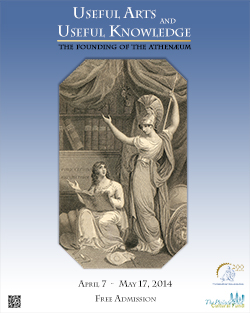 The
Athenaeum of Philadelphia began at the end of 1813 with a simple meeting of a
group of young men, most of whom were University of Pennsylvania graduates and
already or soon-to-be members of the American Philosophical Society, the
Library Company, and the Philadelphia
Society for Promoting Agriculture. Their goal was to establish “Reading Rooms.” On the 9th of
February 1814 the group adopted the Articles of Constitution and elected a
slate of Officers and a Board. William Tilghman would serve as President, with
James Mease, M.D., Vice-President, and Roberts Vaux, Treasurer. The Board of
Managers included, among others, Nicholas Biddle, Robert Hobart Smith, Thomas
Isaac Wharton, and Benjamin Chew, Jr., all names prominent in their
professions. At this February 9th meeting the organization was formally titled
“The Athenaeum of Philadelphia,” using the title that had become popular
for membership libraries with its connection to Athena, Greek Goddess of
Wisdom. On March 7, 1814 the rooms formally opened. Employing the Athenaeum's
rich archives, "Useful Arts and Useful Knowledge" focuses on the
early days of the Athenaeum, its officers, and the first books and magazines
purchased. The
Athenaeum of Philadelphia began at the end of 1813 with a simple meeting of a
group of young men, most of whom were University of Pennsylvania graduates and
already or soon-to-be members of the American Philosophical Society, the
Library Company, and the Philadelphia
Society for Promoting Agriculture. Their goal was to establish “Reading Rooms.” On the 9th of
February 1814 the group adopted the Articles of Constitution and elected a
slate of Officers and a Board. William Tilghman would serve as President, with
James Mease, M.D., Vice-President, and Roberts Vaux, Treasurer. The Board of
Managers included, among others, Nicholas Biddle, Robert Hobart Smith, Thomas
Isaac Wharton, and Benjamin Chew, Jr., all names prominent in their
professions. At this February 9th meeting the organization was formally titled
“The Athenaeum of Philadelphia,” using the title that had become popular
for membership libraries with its connection to Athena, Greek Goddess of
Wisdom. On March 7, 1814 the rooms formally opened. Employing the Athenaeum's
rich archives, "Useful Arts and Useful Knowledge" focuses on the
early days of the Athenaeum, its officers, and the first books and magazines
purchased.
Dates: April 7 - May 17, 2014
Exploring
The Athenaeum-Tips of the Iceberg:
Documents
of Washington Square
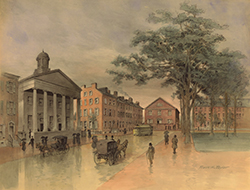 Though
the Athenaeum didn’t move to Washington Square until 1847, its collections
contain documentation of William Penn’s “South East Square” as far back
as 1683. The highlight of this talk is Frank H Taylor’s watercolor,
“A Southwestern View of Washington Square,” c. 1925.
Curator Bruce Laverty will show this and other significant maps, manuscripts,
architectural drawings and photographs that illustrate the fascinating history
of our immediate neighborhood. Though
the Athenaeum didn’t move to Washington Square until 1847, its collections
contain documentation of William Penn’s “South East Square” as far back
as 1683. The highlight of this talk is Frank H Taylor’s watercolor,
“A Southwestern View of Washington Square,” c. 1925.
Curator Bruce Laverty will show this and other significant maps, manuscripts,
architectural drawings and photographs that illustrate the fascinating history
of our immediate neighborhood.
Wednesday, April 2, 2014,
12:00-1:00PM
Free. RSVP to 215-925-2688 or events@PhilaAthenaeum.org
This event is one in a monthly
series highlighting items from the Athenaeum's collections on the occasion
of our 200th anniversary.
Richard
Morris Hunt Symposium
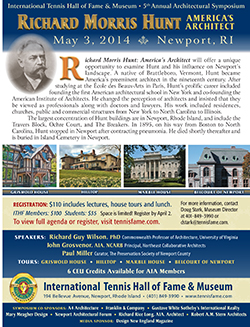 Richard
Morris Hunt: America’s Architect will offer a unique opportunity to
examine Hunt and his influence on Newport’s landscape. A native of
Brattleboro, Vermont, Hunt became America’s preeminent architect in the
nineteenth century. After studying at the École des Beaux-Arts in Paris, Hunt’s
prolific career included founding the first American architectural school in
New York and co-founding the American Institute of Architects. He changed the
perception of architects and insisted that they be viewed as professionals
along with doctors and lawyers. His work included residences, churches, public
and commercial structures from New York to North Carolina to Illinois. The
largest concentration of Hunt buildings are in Newport, Rhode Island, and
include the Travers Block, Ochre Court, and The Breakers. In 1895, on his way
from Boston to North Carolina, Hunt stopped in Newport after contracting
pneumonia. He died shortly thereafter and is buried in Island Cemetery in
Newport. Richard
Morris Hunt: America’s Architect will offer a unique opportunity to
examine Hunt and his influence on Newport’s landscape. A native of
Brattleboro, Vermont, Hunt became America’s preeminent architect in the
nineteenth century. After studying at the École des Beaux-Arts in Paris, Hunt’s
prolific career included founding the first American architectural school in
New York and co-founding the American Institute of Architects. He changed the
perception of architects and insisted that they be viewed as professionals
along with doctors and lawyers. His work included residences, churches, public
and commercial structures from New York to North Carolina to Illinois. The
largest concentration of Hunt buildings are in Newport, Rhode Island, and
include the Travers Block, Ochre Court, and The Breakers. In 1895, on his way
from Boston to North Carolina, Hunt stopped in Newport after contracting
pneumonia. He died shortly thereafter and is buried in Island Cemetery in
Newport.
6 CEU credits for AIA members.
Where: International Tennis Hall of Fame & Museum, 194 Bellevue
Ave., Newport, RI
When: May 3, 2014
For more information visit: www.tennisfame.com
or click the image of the program above.
Leonard
Tantillo Art Exhibition
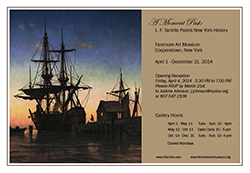 An
exhibition of Leonard Tantillo's artwork has opened at the Fenimore Art
Museum. You may remember Leonard from his talk here at the Athenaeum in
March 2013. The exhibition, A Moment Past: L.F. Tantillo Paints New York
History will be open from April 1-December 14, 2014. Visit www.Fenimore
ArtMuseum.org for additional information or click the image of the
opening reception invitation to the left. An
exhibition of Leonard Tantillo's artwork has opened at the Fenimore Art
Museum. You may remember Leonard from his talk here at the Athenaeum in
March 2013. The exhibition, A Moment Past: L.F. Tantillo Paints New York
History will be open from April 1-December 14, 2014. Visit www.Fenimore
ArtMuseum.org for additional information or click the image of the
opening reception invitation to the left.
This
Month In 1814: A Look Back At The Athenaeum's Founding Year
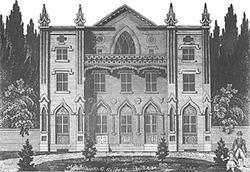 During
the month of April 1814 (the second month the reading rooms were open),
the managers of the Athenaeum were primarily busy making purchases. The
Furnishing Committee reported that they had spent $178.37 on items such as
a stove, an oil lamp and snuffers, a minute book, carpentry work and sign
hanging. Meanwhile, the Purchasing Committee had spent $371.48
accumulating items for the collection. Among the purchases were eight
volumes of Wilson's Ornithology, maps of New York, Connecticut and
Canada, and various periodicals and newspapers. During
the month of April 1814 (the second month the reading rooms were open),
the managers of the Athenaeum were primarily busy making purchases. The
Furnishing Committee reported that they had spent $178.37 on items such as
a stove, an oil lamp and snuffers, a minute book, carpentry work and sign
hanging. Meanwhile, the Purchasing Committee had spent $371.48
accumulating items for the collection. Among the purchases were eight
volumes of Wilson's Ornithology, maps of New York, Connecticut and
Canada, and various periodicals and newspapers.
About two dozen new subscribers were added at the April
18th board meeting. One of the new additions was Captain Turner Camac
(1751-1830). Camac was born in Lurgan, Ireland and, after attending Dublin
College, served as Captain of the 2nd Battalion Infantry for the East India
Company. He married into the Penn family in 1795 and made Philadelphia his
home in 1804 in order to manage his wife's property. Camac Street is named
for this early Athenaeum member.
Another new subscriber that month was John
Dorsey (1795-1821), a merchant and amateur architect who had
designed the first home of the Pennsylvania Academy of the Fine Arts
(1805), and the "Gothic Mansion" at 1217 Chestnut Street (c.1810).
Above:
Dorsey's "Gothic
Mansion." From The Casket: Flowers of Literature, Wit and
Sentiment, No. 10 (October 1830), 456.
Hours:
Monday-Friday:
9:00am-5:00pm
First
three Saturdays of the month: 11:00am-3:00pm (excluding
July and August).
 Location: Location:
219
S. 6th Street
Philadelphia,
PA 19106
The
building is accessible to persons with disabilities.
Group tours and
research visits are by appointment only.
The
Athenaeum does not share this mailing list.
You
can Subscribe
or Unsubscribe
at the Athenaeum website.
To
read past issues, visit the
Newsletter
Archive.
|

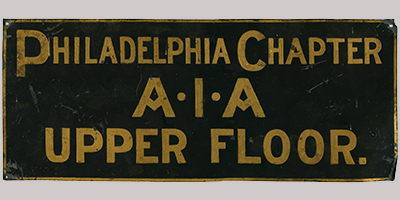





 During
the month of April 1814 (the second month the reading rooms were open),
the managers of the Athenaeum were primarily busy making purchases. The
Furnishing Committee reported that they had spent $178.37 on items such as
a stove, an oil lamp and snuffers, a minute book, carpentry work and sign
hanging. Meanwhile, the Purchasing Committee had spent $371.48
accumulating items for the collection. Among the purchases were eight
volumes of Wilson's Ornithology, maps of New York, Connecticut and
Canada, and various periodicals and newspapers.
During
the month of April 1814 (the second month the reading rooms were open),
the managers of the Athenaeum were primarily busy making purchases. The
Furnishing Committee reported that they had spent $178.37 on items such as
a stove, an oil lamp and snuffers, a minute book, carpentry work and sign
hanging. Meanwhile, the Purchasing Committee had spent $371.48
accumulating items for the collection. Among the purchases were eight
volumes of Wilson's Ornithology, maps of New York, Connecticut and
Canada, and various periodicals and newspapers.
 Location:
Location: